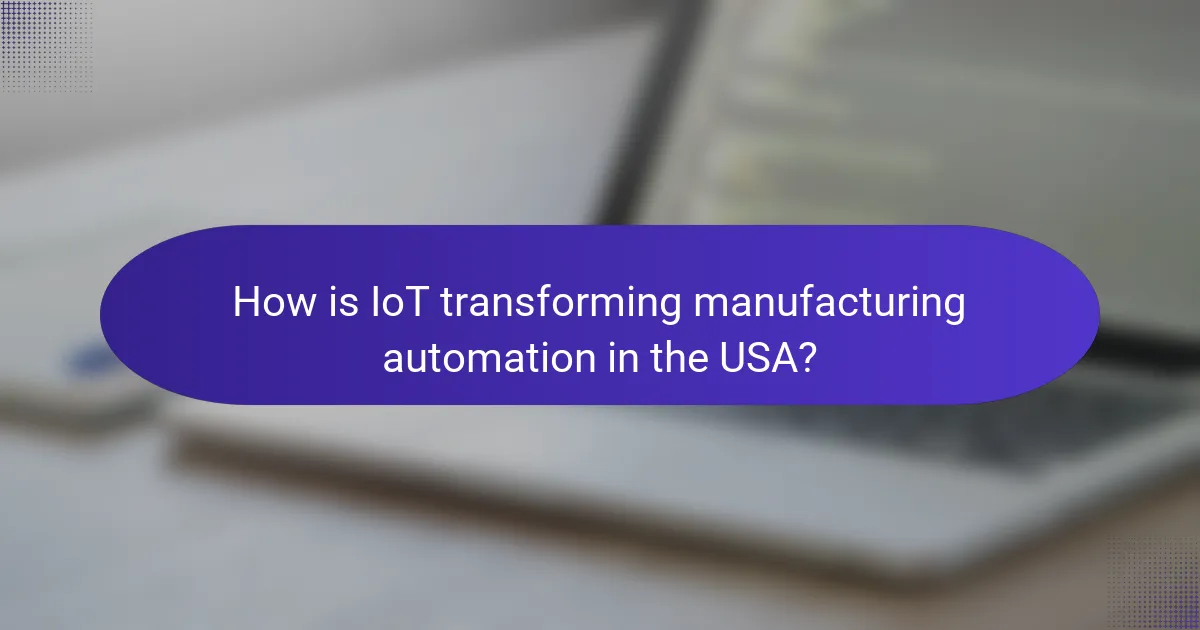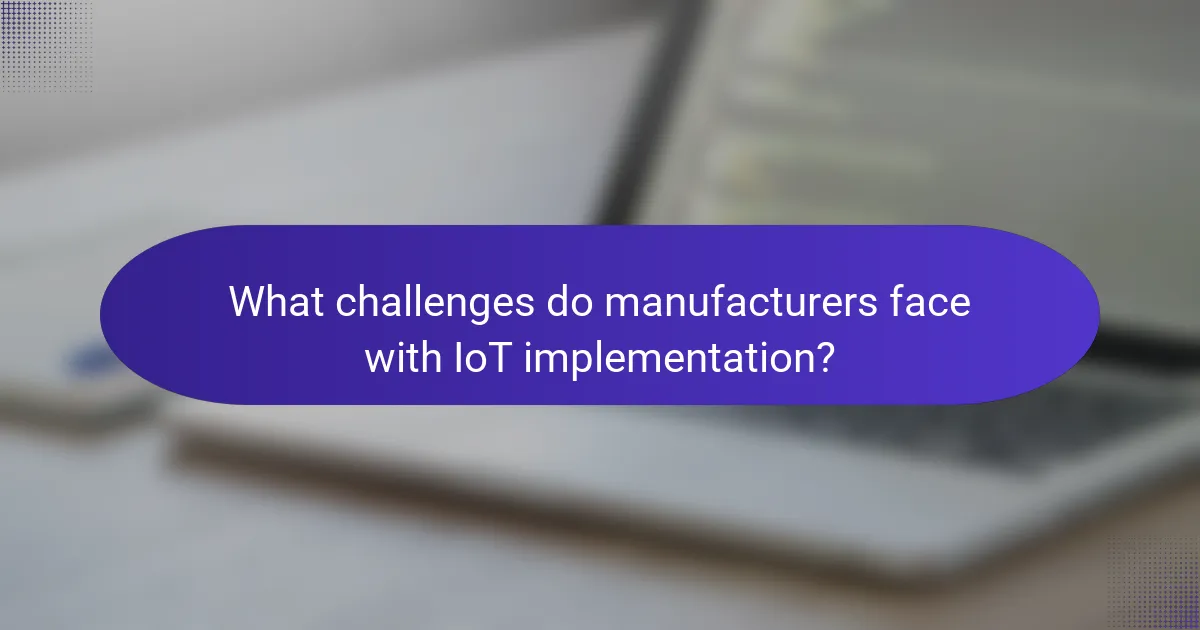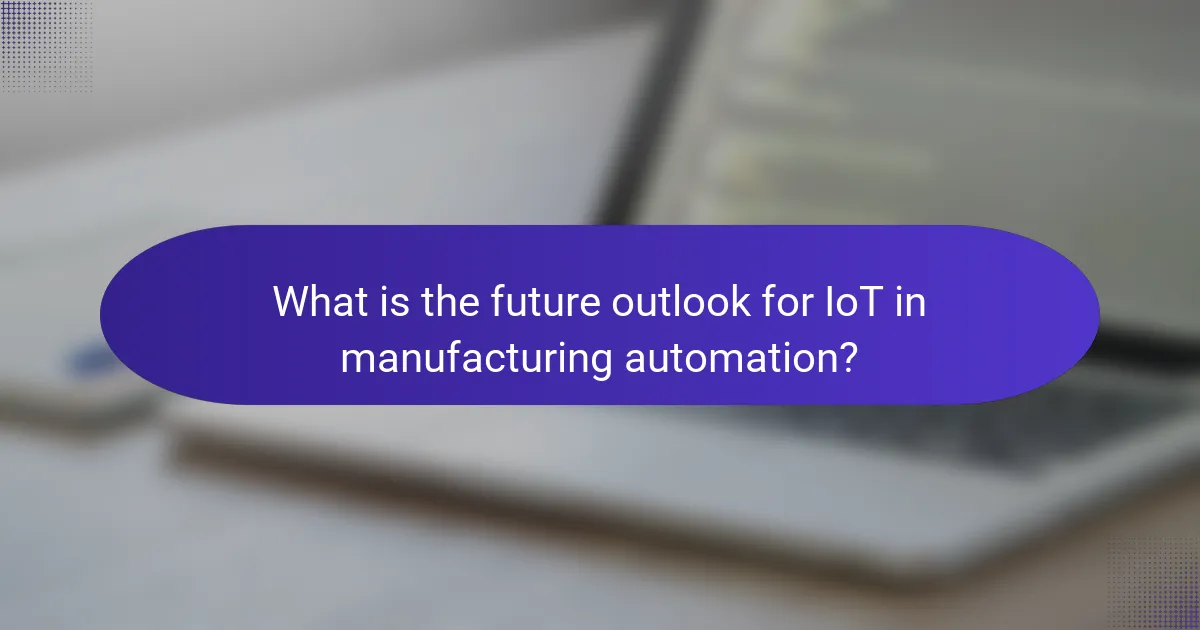The Internet of Things (IoT) is revolutionizing manufacturing automation by facilitating real-time data collection and analysis, which boosts operational efficiency. By connecting machines and systems, IoT empowers manufacturers to make smarter decisions and optimize processes, paving the way for advanced technologies like AI and machine learning, as well as the emergence of smart factories.

How is IoT transforming manufacturing automation in the USA?
The Internet of Things (IoT) is significantly transforming manufacturing automation in the USA by enabling real-time data collection and analysis, which enhances operational efficiency. This technology allows manufacturers to connect machines and systems, leading to smarter decision-making and streamlined processes.
Increased efficiency through real-time data
Real-time data collection is a cornerstone of IoT in manufacturing, allowing companies to monitor operations continuously. Sensors and connected devices provide instant feedback on machine performance, leading to quicker adjustments and reduced downtime.
For instance, manufacturers can track production metrics like output rates and machine health, enabling them to optimize workflows. This proactive approach can result in efficiency improvements of 20-30%, depending on the industry and implementation level.
Enhanced predictive maintenance capabilities
IoT facilitates predictive maintenance by analyzing data from equipment to predict failures before they occur. This capability minimizes unexpected breakdowns and extends the lifespan of machinery, ultimately saving costs associated with repairs and lost production time.
Using historical data and machine learning algorithms, manufacturers can schedule maintenance during non-peak hours, reducing disruptions. Implementing predictive maintenance can lead to maintenance cost reductions of 10-40%, depending on the scale of operations.
Improved supply chain management
IoT enhances supply chain management by providing visibility and tracking throughout the production process. Connected devices allow manufacturers to monitor inventory levels, shipment statuses, and supplier performance in real time.
This transparency helps in making informed decisions regarding inventory replenishment and logistics, reducing excess stock and improving order fulfillment rates. Companies leveraging IoT for supply chain management often see improvements in delivery times and customer satisfaction, contributing to a more agile manufacturing environment.

What are the key trends in IoT for manufacturing automation?
Key trends in IoT for manufacturing automation include the increasing adoption of advanced technologies like AI and machine learning, the integration of edge computing, and the growth of smart factories. These trends are reshaping how manufacturers operate, enhancing efficiency, productivity, and decision-making processes.
Adoption of AI and machine learning
The adoption of AI and machine learning in manufacturing automation allows for predictive maintenance, quality control, and process optimization. By analyzing data from connected devices, manufacturers can identify patterns and anomalies, leading to reduced downtime and improved product quality.
For instance, AI algorithms can predict equipment failures before they occur, enabling timely interventions. Companies should consider investing in AI solutions that integrate seamlessly with their existing IoT infrastructure to maximize benefits.
Integration of edge computing
Edge computing enhances IoT in manufacturing by processing data closer to the source, reducing latency and bandwidth usage. This is crucial for real-time decision-making and operational efficiency, as it allows for immediate analysis of data generated by machines and sensors.
Manufacturers should evaluate their network capabilities to support edge computing solutions. Implementing edge devices can lead to faster response times and improved data security, as sensitive information is processed locally rather than transmitted to centralized cloud servers.
Growth of smart factories
The growth of smart factories is characterized by the use of interconnected devices and systems that communicate and collaborate autonomously. This trend leads to increased flexibility, scalability, and efficiency in production processes.
Smart factories leverage IoT technologies to create a more agile manufacturing environment. Companies should focus on integrating IoT solutions that facilitate automation and data sharing across all levels of production, ensuring a cohesive and responsive manufacturing ecosystem.

What are the benefits of IoT in manufacturing automation?
The Internet of Things (IoT) significantly enhances manufacturing automation by improving efficiency, reducing costs, and increasing product quality. By integrating smart devices and sensors, manufacturers can gain real-time insights, streamline operations, and make informed decisions.
Cost reduction through optimized operations
IoT enables manufacturers to optimize operations by providing data-driven insights into production processes. This can lead to lower operational costs through better resource management, predictive maintenance, and reduced downtime. For instance, companies can save tens of thousands of dollars annually by minimizing equipment failures and enhancing energy efficiency.
Implementing IoT solutions often involves initial investments, but the long-term savings can outweigh these costs. Companies should focus on identifying key areas where IoT can deliver the most significant impact, such as supply chain management and inventory control.
Increased product quality and consistency
With IoT, manufacturers can monitor quality parameters in real-time, ensuring that products meet specified standards. Sensors can detect deviations from quality benchmarks, allowing for immediate corrective actions. This leads to fewer defects and higher customer satisfaction.
Additionally, IoT facilitates consistent production processes by automating quality checks and maintaining optimal conditions. For example, a manufacturer might use IoT devices to monitor temperature and humidity in a facility, ensuring that these factors remain within ideal ranges for product integrity.
Enhanced safety and compliance
IoT technology plays a crucial role in improving workplace safety and ensuring compliance with industry regulations. Smart sensors can monitor environmental conditions and detect hazardous situations, alerting workers and management in real-time. This proactive approach helps prevent accidents and injuries.
Moreover, IoT can assist in maintaining compliance with safety standards and regulations by providing detailed records of safety inspections and incidents. Manufacturers can leverage this data to demonstrate adherence to regulations, which is vital for avoiding penalties and maintaining a good reputation.

What challenges do manufacturers face with IoT implementation?
Manufacturers encounter several challenges when implementing IoT technologies, including data security, integration with existing systems, and high initial investment costs. Addressing these issues is crucial for successful adoption and maximizing the benefits of IoT in manufacturing.
Data security and privacy concerns
Data security and privacy are significant challenges for manufacturers adopting IoT. The interconnected nature of IoT devices increases vulnerability to cyberattacks, potentially leading to data breaches and operational disruptions. Manufacturers must prioritize robust security measures to protect sensitive information.
Implementing encryption, regular software updates, and access controls can help mitigate these risks. Additionally, adhering to data protection regulations, such as GDPR in Europe, is essential to ensure compliance and maintain customer trust.
Integration with legacy systems
Integrating IoT solutions with legacy systems poses a major hurdle for manufacturers. Many existing systems were not designed to communicate with modern IoT devices, leading to compatibility issues and operational inefficiencies. A thorough assessment of current infrastructure is necessary to identify integration points.
Manufacturers may need to invest in middleware or custom APIs to facilitate communication between old and new systems. Gradual implementation and pilot testing can help minimize disruptions during the transition.
High initial investment costs
The initial investment costs for IoT implementation can be substantial, which deters many manufacturers from adopting these technologies. Expenses may include purchasing new devices, software licenses, and infrastructure upgrades. However, the long-term benefits often outweigh these upfront costs.
To manage expenses, manufacturers can explore phased implementation strategies, starting with pilot projects that demonstrate ROI before full-scale deployment. Additionally, seeking government grants or incentives for technology adoption may help offset costs.

How to choose the right IoT solutions for manufacturing?
Selecting the right IoT solutions for manufacturing involves evaluating various factors such as scalability, vendor reliability, and industry-specific features. These considerations ensure that the chosen technology aligns with operational goals and can adapt to future needs.
Evaluate scalability and flexibility
Scalability and flexibility are crucial when choosing IoT solutions for manufacturing. A scalable system can grow with your business, accommodating increased data volume and additional devices without significant overhauls. Look for solutions that allow easy integration of new sensors or machinery as production demands change.
Flexibility is equally important, as it enables the system to adapt to different manufacturing processes or shifts in market demand. Consider platforms that support various protocols and can be customized to fit specific operational requirements.
Assess vendor support and reliability
Vendor support and reliability are key factors in ensuring the longevity of your IoT solutions. A reputable vendor should offer robust customer support, including training, troubleshooting, and regular updates. Check for reviews or case studies that highlight the vendor’s responsiveness and service quality.
Reliability can be gauged by the vendor’s track record and the technology’s uptime. Aim for solutions that meet industry standards and have built-in redundancies to minimize downtime and maintain production efficiency.
Consider industry-specific features
Industry-specific features can significantly enhance the effectiveness of IoT solutions in manufacturing. Look for systems that offer functionalities tailored to your sector, such as predictive maintenance for machinery or real-time monitoring of production lines. These features can lead to improved efficiency and reduced operational costs.
Additionally, consider compliance with relevant regulations and standards in your industry. Solutions that incorporate these features can help ensure that your operations remain compliant while maximizing productivity.

What is the future outlook for IoT in manufacturing automation?
The future of IoT in manufacturing automation is poised for significant growth, driven by enhanced efficiency, data-driven decision-making, and integration of advanced technologies. As industries adopt IoT solutions, they can expect improved operational performance and greater adaptability to market demands.
Increased focus on sustainability
Manufacturers are increasingly prioritizing sustainability through IoT technologies, which enable real-time monitoring of energy consumption and waste management. By utilizing IoT sensors, companies can track resource usage and identify areas for improvement, leading to reduced environmental impact.
For example, factories can implement IoT systems to optimize energy use, potentially lowering costs by 10-30% while meeting regulatory standards for emissions. This shift not only benefits the environment but can also enhance brand reputation among eco-conscious consumers.
Advancements in 5G connectivity
The rollout of 5G technology is set to revolutionize IoT in manufacturing by providing faster data transmission and lower latency. This connectivity allows for seamless integration of devices, enabling real-time analytics and immediate responses to operational changes.
With 5G, manufacturers can expect to enhance automation processes, such as remote monitoring and predictive maintenance, which can reduce downtime by significant margins. Companies should consider upgrading their infrastructure to leverage these advancements effectively and stay competitive in the evolving market.



